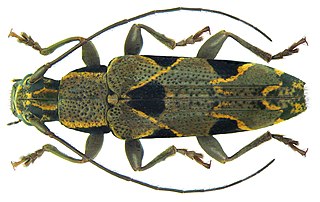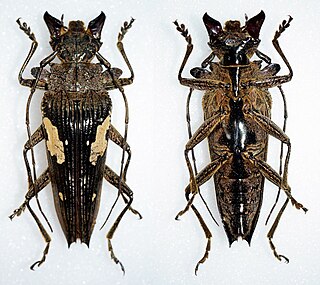Lieutenant general, lieutenant-general and similar is a three-star military rank used in many countries. The rank traces its origins to the Middle Ages, where the title of lieutenant general was held by the second in command on the battlefield, who was normally subordinate to a captain general.
As the number of German troops committed to the North African Campaign of World War II grew from the initial commitment of a small corps the Germans developed a more elaborate command structure and placed the enlarged Afrika Korps, with Italian units under this new German command and a succession of commands were created to manage Axis forces in Africa:

Ettore Bastico was an Italian military officer before and during World War II. In addition to being a general of the Royal Italian Army, he was also a senator and governor. He held high commands during the Second Italo-Abyssinian War (Ethiopia), the Spanish Civil War, and the North African Campaign.

The Chilean angelshark is an angelshark of the family Squatinidae found in the subtropical waters of Chile, that grows up to 1.03 metres in length. The holotype is lost. Reproduction is ovoviviparous.

Banksia armata, commonly known as Prickly Dryandra, is a shrub endemic to Western Australia.

Vasile Bătrânac was the head of the anti-Soviet group Arcaşii lui Ştefan and a political prisoner in the Soviet Union.
Armata Neagră was an organized anti-Soviet group in the Moldovan SSR (Bessarabia).
The Eleventh Army was one of the field armies of the Royal Italian Army during World War II. It was formed in November 1940 for service in the Greco-Italian War, and after the German invasion of Greece and the capitulation of that country in April 1941, assumed occupation duties in the Greek mainland. It remained on station in Greece until the Italian armistice in 1943, when it was forcibly disbanded by the Germans.

The "Armata" Universal Combat Platform is a Russian advanced next generation modular heavy military tracked vehicle platform. The Armata platform is the basis of the T-14, the T-15, a combat engineering vehicle, an armoured recovery vehicle, a heavy armoured personnel carrier, a tank support combat vehicle and several types of self-propelled artillery, including the 2S35 Koalitsiya-SV under the same codename based on the same chassis. It is also intended to serve as the basis for artillery, air defense, and NBC defense systems. The new "Armata" tank platform is meant to replace the older Russian MBTs and APCs that are currently used by the Russian military.

Tmesisternini is a tribe of beetles in the subfamily Lamiinae containing the following genera:
Sepicana is a genus of longhorn beetles of the subfamily Lamiinae, containing the following species:

The T-14Armata is a next-generation Russian main battle tank based on the Armata Universal Combat Platform—the first series-produced next-generation tank. The Russian Army initially planned to acquire 2,300 T-14s between 2015 and 2020. Production and fiscal shortfalls delayed this to 2025, and then to the cancellation of the main production run. The test batch of 100 is to be delivered and deployed to the Taman division, with delivery expected to be completed by 2020; tanks will be transferred only after the completion of all state tests.

The T-15 Armata, with industrial designation "Object 149", is a Russian heavy infantry fighting vehicle first seen in public in 2015 during rehearsals for the Moscow Victory Day Parade. The T-15 is expected to replace the BMP-2 and MT-LB based platforms of the Russian Ground Forces.
Sepicana albomaculata is a species of beetle in the family Cerambycidae. It was described by Charles Joseph Gahan in 1915.

Sepicana arfakensis is a species of beetle in the family Cerambycidae. It was described by Stephan von Breuning in 1950. It is known from Indonesia.
Sepicana hauseri is a species of beetle in the family Cerambycidae. It was described by Per Olof Christopher Aurivillius in 1907.
Sepicana migsominea is a species of beetle in the family Cerambycidae. It was described by E. Forrest Gilmour in 1949.
Sepicana shanahani is a species of beetle in the family Cerambycidae. It was described by Gressitt in 1984.
The XXVI Army Corps was an infantry corps of the Royal Italian Army during World War I, the Italian invasion of Albania, and the Greco-Italian War and the subsequent Italian occupation of Greece during World War II.
The VIII Army Corps was an infantry corps of the Royal Italian Army during World War II, when it participated in the Italian invasion of Albania, and the Greco-Italian War and the subsequent Italian occupation of Greece.










